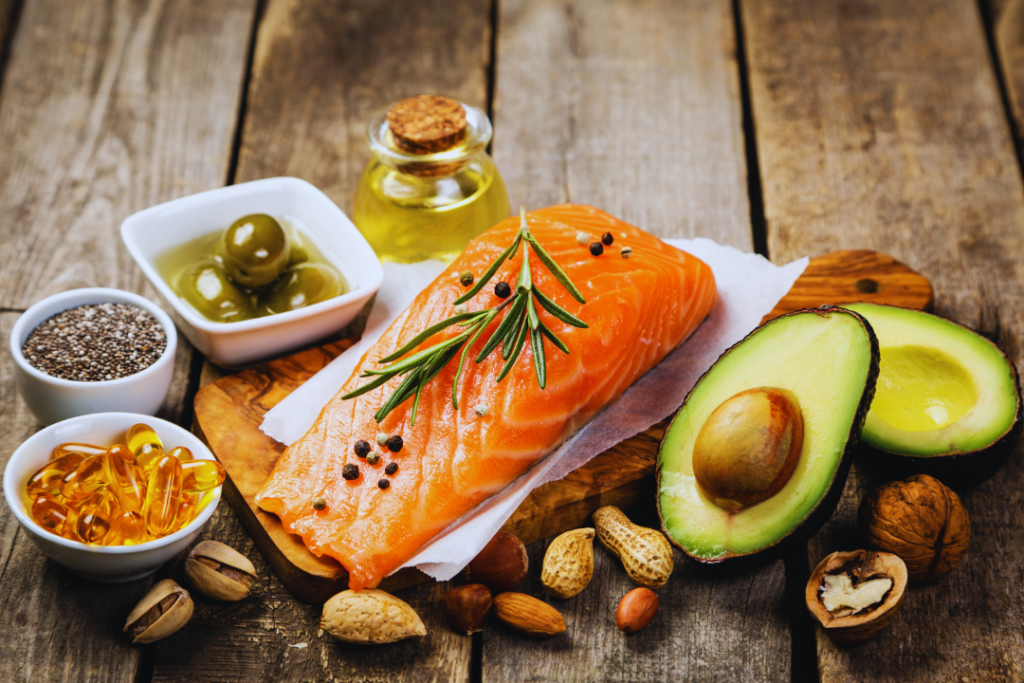
Many people try to avoid fat in their diets, but dietary fat plays an important role in the body. In fact, fat is one of the three essential macronutrients. Read on to learn about the different types of fat, including saturated fat, unsaturated fat, and trans fat. Discover which fat you should eat a lot of, which fat you should eat a little of, and which fat you should not eat at all.
Table of Contents
Schedule a Free Discovery Call
Get started on the road to a better, healthier you. Leave your name and phone number and Romi will reach out to you to schedule a free consultation.
By submitting this form you agree to be contacted via text/email/phone. Reply “stop” to opt-out at any time.
**Your privacy is important. Your information will not be shared. Read more about our privacy policy here.
Fat is an Essential Macronutrient
As an essential macronutrient, fat is vital to our bodies. Besides its main role of energy storage, fatty tissues also:
- Regulate hormones involved in appetite and metabolism
- Play an important role in the immune system
- Help the body absorb nutrients from the food you eat (i.e. fat helps absorb fat-soluble vitamins, such as Vitamins A, E, and D.)
- Supplies a fatty membrane for cells vital to proper cell function
- Insulate the body and regulate temperature
- Provides a protective cushion around our organs
What are Macronutrients?
“Macronutrients” refers to the nutrients your body needs in the largest amounts. The three main macronutrients are: fat, protein, and carbohydrates. These macronutrients are considered “essential” because the body needs them to function optimally, but cannot make, or cannot make enough of these nutrients on its own. Therefore, the body depends on getting these nutrients through your diet.
What are the Different Types of Fat?
There are four main types of fat that can be part of your daily diet (“dietary fats.”) These are:
- Saturated fats
- Trans fats
- Monounsaturated fats
- Polyunsaturated fats
Saturated Fat & Unsaturated Fat
Not all fats are created equal. Some fats are healthy for you. Healthy fats, also known as unsaturated fats, include monounsaturated fats and polyunsaturated fats. Trans fats are bad fats. Saturated fat can be both good or bad for you, depending on what your body needs, the source of the saturated fat, and the amount you take into your body. Too much saturated fat can harm your cardiovascular health.
The 3 Main Types of Fat
The four types of fat can be broken down into two broad categories: saturated or unsaturated:
Saturated Fat
- Saturated fats mostly come from meat and dairy sources. These fats are also known as solid fats because they are generally solid at room temperature. Solid fats tend to be shelf-stable for a long time. However, when it comes to cardiovascular risk, saturated fat from meat should be avoided. However, full-fat dairy products do not hurt your cardiovascular health, and in some cases, may actually improve it.
Unsaturated Fat
- Unsaturated fats include two other types of fats: monounsaturated fat and polyunsaturated fat. Unsaturated fats come from plant-sources and fortified foods such as eggs and dairy, as well as fish, seaweed, and grass-fed animal products. They provide the body with many health benefits. These fats are generally liquid even when refrigerated and have a shorter shelf life than saturated fats.
Trans Fat
- Trans fat is an unsaturated fat, but don’t let that fool you. Trans fat is notoriously unhealthy. Fortunately, this “bad fat” is slowly getting eliminated from foods. Trans fat is a polyunsaturated fat that is processed to gives food a long shelf-life. Most processed foods like chips, cookies, cakes, and other baked goods typically contain these hydrogenated fats.
It is important to trade out trans fats and saturated fats for polyunsaturated or monounsaturated fats in your diet. Doing so decreases your risk of certain diseases, including heart disease, stroke, and type 2 diabetes.
What Foods are High in Saturated Fats?
- Butter, lard, mayo
- Fatty meats- bacon, beef, breakfast sausages, hot dogs, lamb, pork, processed meats, some cold cuts
- Whole fat dairy products
- Ice cream
- Palm and coconut oils
- Chocolate and desserts
- Savory snack mixes
What Foods are High in Unsaturated Fats?
- Nuts
- Seeds
- Plant-based oils, such as olive oil
- Fatty seafood (e.g., salmon and tuna)
- Avocado
How Much Fat Should I Include in My Diet?
The recommended dietary fat intake is roughly 20% to 35% of your daily calories. The majority of your dietary fat should come from healthy fats (monounsaturated and polyunsaturated fats.)
Saturated fat can be a part of a healthy diet. However, it is important to regulate how much saturated fat you take in. Guidelines recommend saturated fat being no more than 10% of your daily calories.
The Skinny on Fat
Fat has a notorious rap. But now you know that not all fat is bad for you. If you want to learn more about nutrition and receive a personalized meal plan, contact Romi today to schedule a free consultation.
Schedule a Free Discovery Call
Get started on the road to a better, healthier you. Leave your name and phone number and Romi will reach out to you to schedule a free consultation.
By submitting this form you agree to be contacted via text/email/phone. Reply “stop” to opt-out at any time.
**Your privacy is important. Your information will not be shared. Read more about our privacy policy here.
Sources:
Teicholz, Nina. “A short history of saturated fat: the making and unmaking of a scientific consensus.” Current opinion in endocrinology, diabetes, and obesity vol. 30,1 (2023): 65-71. LINK.
Dhaka, Vandana et al. “Trans fats-sources, health risks and alternative approach – A review.” Journal of food science and technology vol. 48,5 (2011): 534-41. LINK.